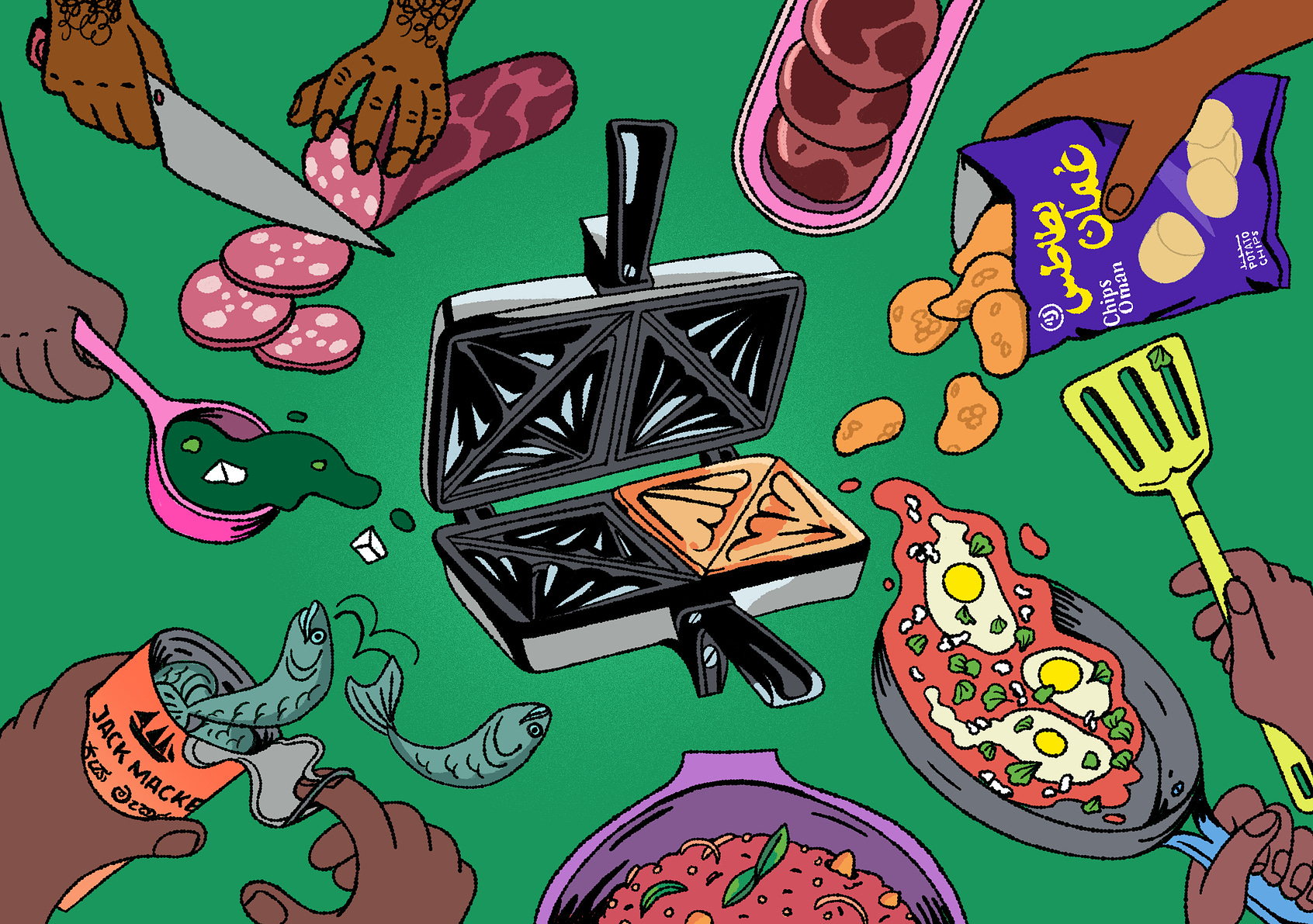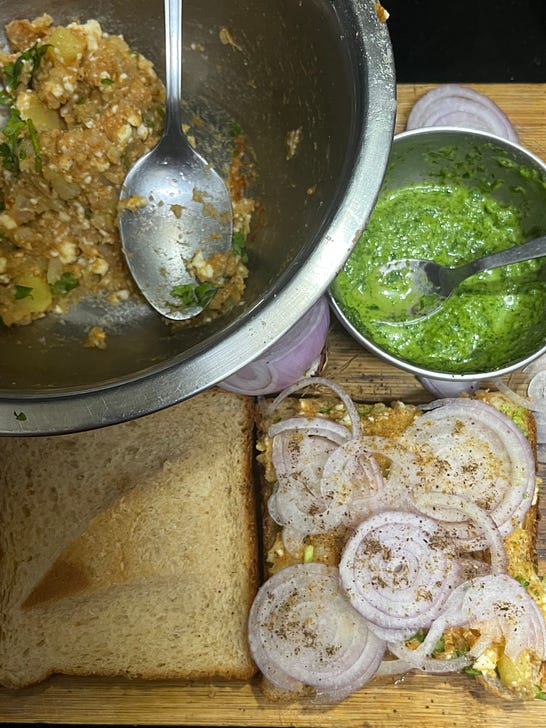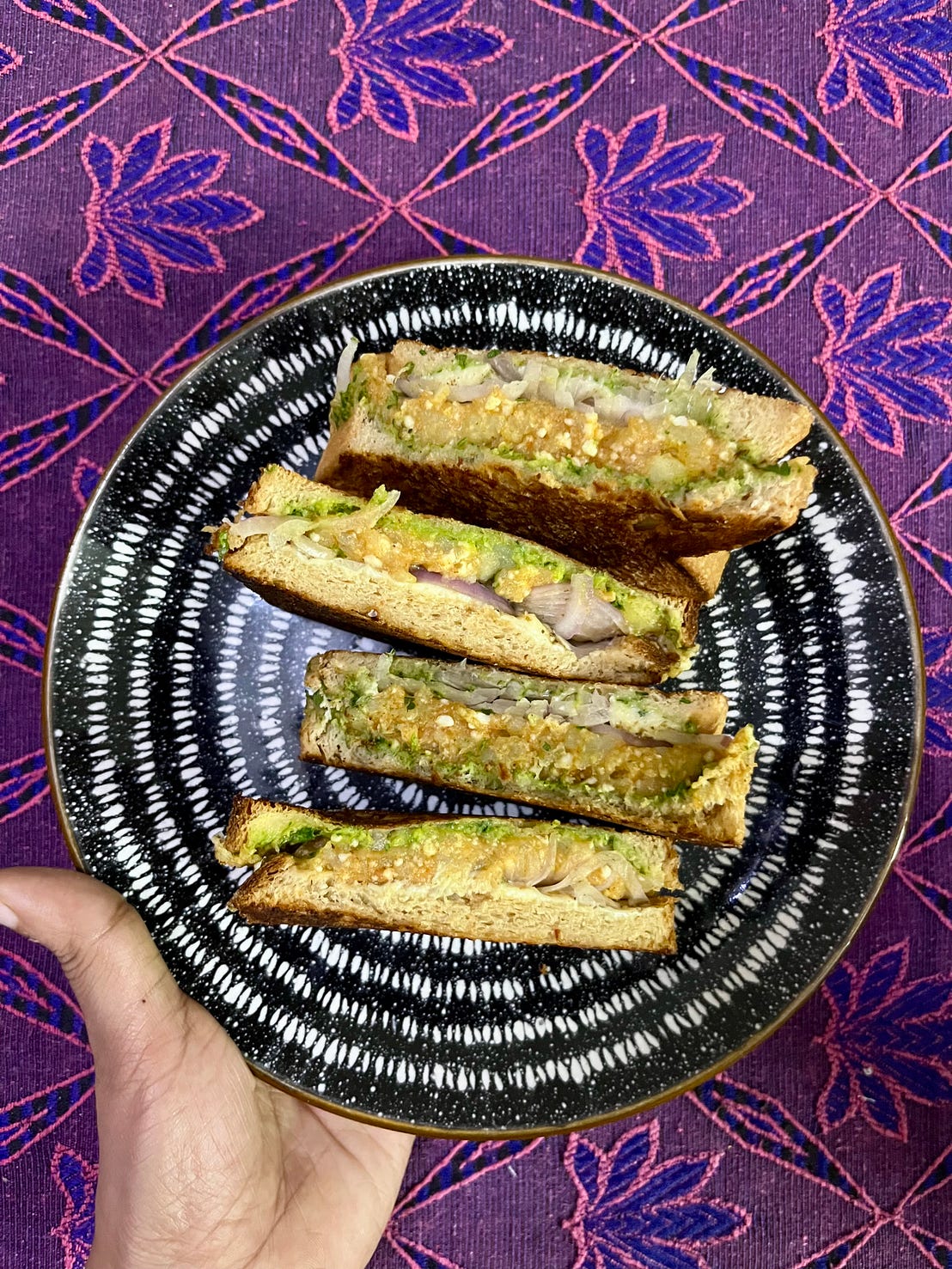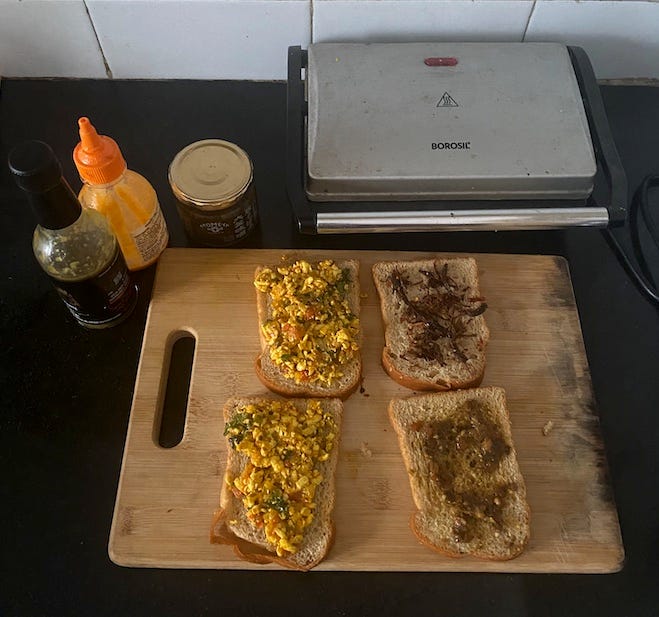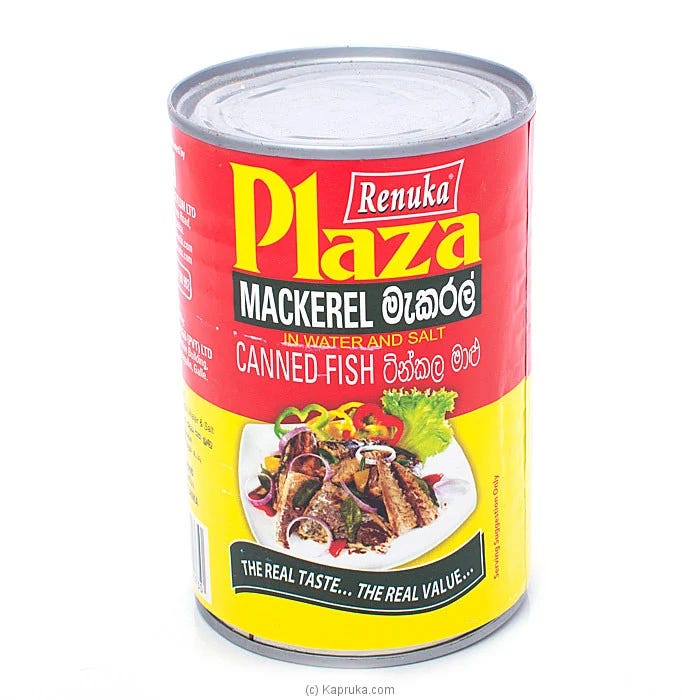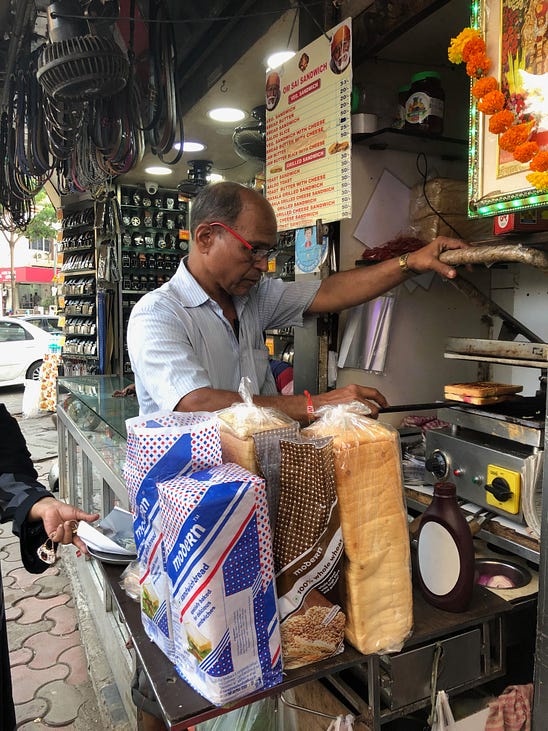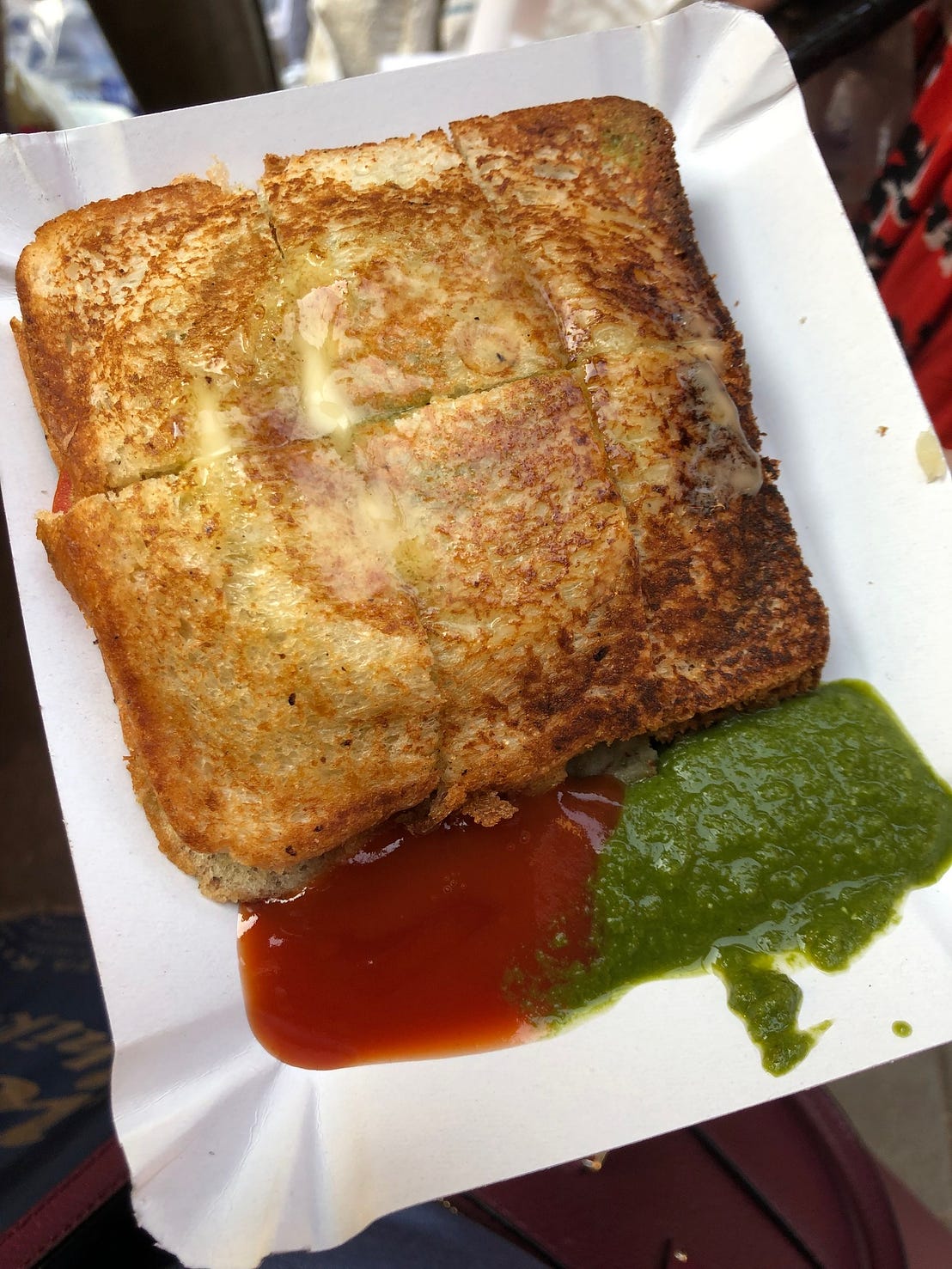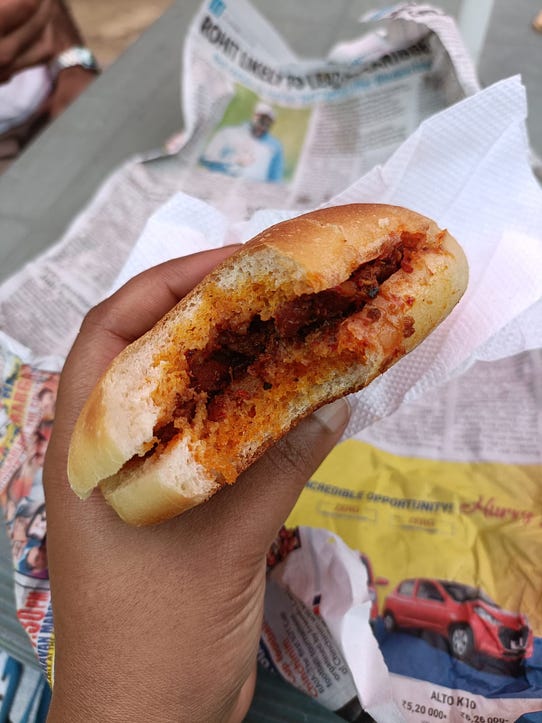A Taxonomy of the South Asian ToastieWherever South Asians are, toasties are sure to follow. Words by Vidya Balachander. Illustration by Kruttika Susarla.
Taxonomy of the South Asian ToastieWherever South Asians are, toasties are sure to follow. Words by Vidya Balachander. Illustration by Kruttika Susarla. After work in Mumbai, crowds huddle around a sandwich stall, making demands about customised fillings: no beetroot, extra cheese, chutney and sev, butter on top. On the Indian Railways, a family unwraps chutney-and-cheese toasties from their foil, passing them around. At home, a mother juggling chores uses leftover tuna cutlets to make toasties for her children’s lunch. Across the subcontinent and beyond, this scene repeats itself in one form or another. Wherever South Asians are, toasties are sure to follow. It was the electric sandwich maker that brought the toastie to the subcontinent, an early iteration of which was produced in the 1920s by Thomas Edison’s company, Edicraft. Lesser-known than his other inventions, the sandwich toaster was part of a line of kitchen equipment described as ‘electric servants’, a categorisation consistent with how American (and later, South Asian) domestic life was changing. With electricity becoming accessible to middle-class homes, high-end electrical appliances were seen as efficient replacements for manual labour, presumably allowing women who worked in kitchens greater control over both the household and their own time. The electric sandwich maker helped create a category of toasted sandwiches – or toasties – with a distinctly South Asian identity. This variety, also sometimes called ‘toast’ (as in ‘chilli cheese toast’), was exciting and flexible, expanding the defined contours of home cooking while not upsetting the delicate balance of the domestic budget. With no history to revere or formula to adhere to, you could use whatever emerged out of the kitchen, put it between two slices of bread (buttered, ideally), and call it a toastie. The South Asian toastie could be anything it wanted to be.
Today, toasties are an efficient way to use up leftovers, like a fish curry from the previous night or vangi bath palya (aubergines stir-fried with spices, usually mixed into rice). Masala potatoes, usually served in masala dosa, are a favourite filling, as are shami kebabs, keema matar, and leftover dal. As condiments, coriander chutney, mango pickle, and pol sambol are all just as valid and beloved. Butter, margarine, oil and ghee can all be used to lend crispness. There is no right or wrong way to make a toastie, and the skills required are modest enough to make it achievable for nearly everyone. I spoke to people from India, Pakistan, and Sri Lanka about toasties for this piece, slicing them into a rough taxonomy that tells a larger story about the subcontinent. Needless to say, these categories are in no way exhaustive or encompassing. Like the cuisines that have guided its creation, the South Asian toastie has infinite lives. The Diaspora OneWhen Fathleela Faisal moved to Saudi Arabia from Sri Lanka in 1991, she took an electric sandwich maker with her. She had seen a few people use one to make ada, an eggy, coconut-flecked cake popular with Sri Lankan Muslims. Her husband was employed as a driver by a local family, and when Fathleela moved, she worked as a part-time housemaid with the same people. While she had intended for the toaster to be a sort of insurance against unfamiliarity, Fathleela instead found herself using it to embrace newness in this new country. Fathleela’s daughter, my friend Sara, says the impetus for using the toastie maker was that her friends at school would not eat the Sri Lankan food her mum prepared. ‘I was so sad, and told my mum that she had to make something that my friends would eat,’ Sara said. ‘She started making toasties after that.’ Most often, the filling was a substantial sambol with canned tuna and onion, flavoured with the usual arsenal of Sri Lankan spices including chilli powder, curry powder, and lime juice. But the runaway popularity of Fathleela’s toasties also encouraged her to experiment with other fillings, including a Maldive fish sambol made of umbalakada (similar to bonito flakes) and onions, sprinkled with lime and chilli flakes – an umami-packed condiment that made for an especially delicious addition. (Given the complex, unctuous flavour of sambols, they are favoured as fillings for Sri Lankan toasties. These toasties replicate a traditional meal – such as hoppers and seeni sambol – but in a more convenient, portable form.)
Over time, as Fathleela became more familiar with local dishes and tastes, she made shakshuka toasties as well. Her experiments were a way for her and her family to better integrate into their new social landscape, especially as a lower-income family. Sara remembers taking her mother’s toasties on road trips with her friends; for beach outings; to birthday parties. ‘It made me feel good when we could contribute [in this way],’ Fathleela tells me, clearly feeling a sense of accomplishment about being able to make her modest means go further. Being an immigrant is akin to seeing the world askew, and this discomfort can be eased with a gentler hold on one’s culture and cuisine. An openness to finding familiarity in new forms eases the intense disorientation of being distanced from one’s bearings. For the many South Asians across different social strata who moved away in the 1980s and 90s, the toastie served as an easy and relatively low-stress bridge to adjust to a new way of living (and eating). If the fixings for masala dosa are too cumbersome to put together, a masala potato toastie may serve the same function. Maybe a spoonful of Crystal Hot Sauce or Arabic shatta? Why not some crushed Chips Oman? The end result may invoke a masala dosa only in spirit, but it also defies the fixed idea of what a dish should be, allowing it to be reinvented. The Quick Fix One (or the One South Asian Men Can Cook)Traditionally, South Asian meals – like the average rice and curry lunch – have not been structured around the needs of small families. Even a simpler meal, with just one or two elements, requires forethought, the burden of which almost always falls on women. It makes me wonder, tongue firmly in cheek: is there scope for a ‘lite’ version of these cuisines, one that is more adaptive to the cooking abilities (or lack thereof) of the average South Asian man? Can dishes be reimagined for men who – by choice or circumstance – cook for themselves at home? If we were to invent this category, the toastie would have an honorary place within it. One of the toastie’s main appeals is that it is a quick fix; after all, you could scrape together a toastie even from the bare bones of a sparse pantry and refrigerator. For men who enjoy cooking for themselves and their families, toasties can be a playful and satisfying way to experiment with flavour and form. Imesh Liyanage, a Sri Lankan in his early thirties who lives in Bengaluru, told me that he sometimes makes a big batch of sweet-spicy seeni sambol, which forms a part of his regular meals but is ‘also a convenient filling for toasties’. Meanwhile, Pakistani journalist and author Saba Imtiaz tells me that her father is something of a toastie fiend. As the designated cook in the house after Saba’s mother passed, he often turned to toasties to appease Saba’s picky palate, and as a diabetic, he found that eating them for dinner helped keep his blood sugar in check. Over the years, he has experimented with a wide variety of fillings, including shami kebabs, aloo kebabs, boiled eggs, and palak paneer (the last version failed because it made the toastie too soggy). ‘I really liked the qeema and chicken ones’, Saba told me. ‘One of my favourite meals is still a shami kebab toastie with chilli garlic sauce.’ For Priya Saini, a marketing executive based in Ireland, toasties are a way to grapple with the recent loss of her father, who conjured up a variety of toasties, from mashed potatoes and keema matar to homemade pickle with ghee. Even when he got ill, Priya says that her father would still ask for all the ingredients at his bedside. ‘He would assemble them and get mum to grill [the toasties] because he couldn’t make it to the kitchen,’ she said. She now keeps her father’s memory close by making toasties for her two-year-old son. The Wartime OneEsther Hoole, a Sri Lankan Tamil based in Colombo, remembers a time in the 1980s when her family’s meals featured an abundance of meat, fish, and vegetables. This was not uncommon in northern Sri Lanka, before the country’s civil war, which extended from 1983 to 2009. The economic embargo – which was imposed by the Sri Lankan government on the Tamil-dominated Northern and Eastern provinces during this time – chipped away at food security, making everyday essentials like bread, lentils, and fish difficult to access. For Sri Lankan Tamils, the war years and their associated violence caused uncertainty in every aspect of life, but also in their diets. Confronted with displacement, loss of agricultural lands and cattle, and restrictions on fishing, they were forced to make the most of what was available to them. Even though Esther’s family left Jaffna to move to Colombo in the mid-1990s, the memory of the shortages they experienced had a lingering impact on how they ate, particularly on the composition of the tinned fish toastie that her mother and grandmother made. Universally loved across Sri Lanka, the tinned fish toastie is usually made of canned tuna or sardines – inexpensive and accessible proteins – that are zhuzhed up with lime and chillies. But as Esther recounts, ‘There was a lot more potato, onion, and green chilli than there was fish’ in the version she ate at home, because access to canned fish was limited. ‘In retrospect, I think my mother and grandmother stuck to their wartime philosophy of “manaththodaye nalla irruku” [just the smell of the protein is enough],’ she told me in an email. Many of the Sri Lankans I spoke to had nostalgic memories of tinned fish toasties, particularly as a school snack. The same staple wielded a different emotional weight based on circumstance. There is clearly a larger narrative to be told about food and war in the Sri Lankan context. The barely calibratable differences in how a tinned fish toastie is constructed across the country may only be a snippet of this story. But it is also true that without that small detail, a rendering of Sri Lankan food would be incomplete. The Street-Food-Turned-Social-Media OneIn India, commercial white bread (introduced and popularised by both Portuguese and British colonisers) became easily available in the 1960s. Modern, the first Indian brand to manufacture industrial bread, was launched in 1965, while Wibs, the brand that was once most favoured by sandwich vendors across Mumbai, came into existence in 1973. Given the affordability and accessibility of industrially produced bread, street food vendors have embraced it as a staple ingredient. (On the street, electric sandwich makers were preceded by the handheld toaster, which is placed directly over coal embers or a gas stove. Many small vendors still prefer the latter because of its portability.) Processed Amul cheese, which became a staple in the 1980s for its gooey texture that no foreign import could match, also significantly impacted the toastie’s anatomy. The Bombay sandwich, layered with coriander chutney, sliced vegetables, and cheese, is perhaps the most cited example of this type of toastie. But there are endless examples across the country, since the toastie both defines and straddles regional preferences. Delhi has shawarma sandwiches, Indore has tandoori masala grilled toasts, and Kolkata has omelette toasties. In the age of social media as marketing, the crazier the sandwich, the more likely it is to reel in curious customers. Defying convention (and sometimes logic), some street toasties have acquired viral fame. Consider Kolkata’s ‘Fast & Furious Malai Sandwich’, a towering edifice featuring sliced vegetables, mashed potatoes, a heavy hand of butter, and generous slices of the city’s famous malai (cream). This toastie evokes an inescapable sense of curiosity, even if you swear you would never eat it. Or take the ‘Super Huge 5 Layers Hill Sandwich of Nagpur’, which includes four sauces, two kinds of mixed vegetable filling, paneer, and corn, all drowned in butter and cheese. The made-for-views toastie is not only changing the way we eat on the street, but also how we consume the experience through our screens. Its casual excess gives permission for indulgence: to its maker, consumer, and those watching on. 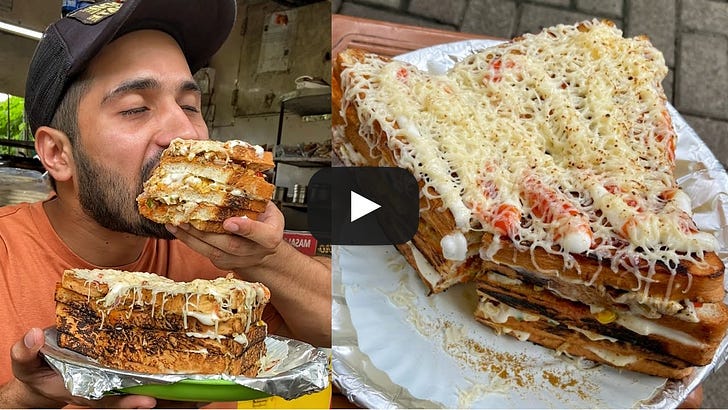 As I conducted the research for this piece, I encountered many toasties – some evergreen classics, others retro throwbacks – but they are all testament to the fact that the South Asian toastie is anything but formulaic. They are also an invitation to momentarily transgress the virtuosity of domestic cooking and flirt with new tastes. The South Asian toastie is rarely the subject when considering the diversity of the subcontinent’s cuisines, but it is a genre in its own right. This brings me back to the idea of the ‘electric servant’, a term which attributed an elevated degree of autonomy to devices while rendering invisible the hands that made them work. While this phrasing may now be outdated, its premise is not. Even the simplest of foods, like a chutney-and-cheese toastie, requires forethought. Who makes the chutney; who ensures that the bread is buttered? Street sandwich-sellers may conjure toasties seemingly out of thin air, but their elaborate mise en place is largely prepared away from the public eye. It’s tempting to think of toasties as ‘easy food’, especially when they serve as an unassuming counterpoint to the grandeur of South Asian foods, but they call into question how we define cuisine. Does it always have to be done by a chef with vast resources at their disposal? Why can’t it also refer to a harrowed working mother looking for quick and satisfying lunchbox options for her picky child? Maybe cuisine would benefit from being seen as an ever-evolving idea – and South Asian toasties are just that. Credits
You’re currently a free subscriber to Vittles . To gain access to our entire back catalogue, you can upgrade your subscription below. |


